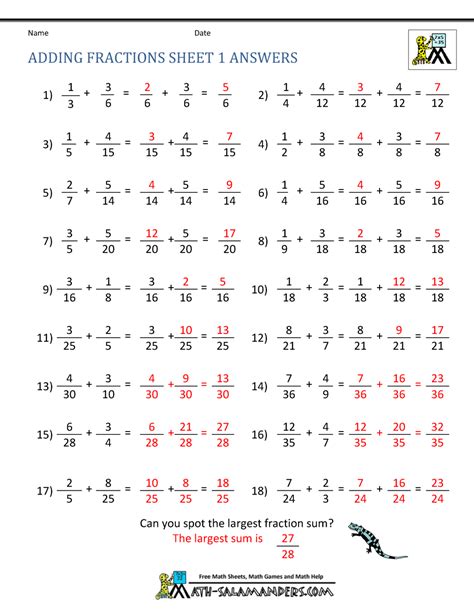Adding Fractions with Different Denominators Made Easy

Adding Fractions with Different Denominators Made Easy

Adding fractions with different denominators can be a challenging task for many students. However, with the right approach and techniques, it can be made easy and straightforward. In this article, we will explore the steps and methods to add fractions with different denominators, making it easy for you to understand and apply.
Understanding Fractions and Denominators

Before we dive into adding fractions with different denominators, let’s first understand what fractions and denominators are. A fraction is a way to represent a part of a whole, and it consists of two parts: the numerator and the denominator. The numerator is the top number, and it tells us how many equal parts we have. The denominator is the bottom number, and it tells us how many parts the whole is divided into.
For example, in the fraction 3⁄4, the numerator is 3, and the denominator is 4. This means we have 3 equal parts out of a total of 4 parts.
The Problem with Different Denominators

When we add fractions with the same denominator, it’s straightforward. We simply add the numerators and keep the same denominator. However, when we have fractions with different denominators, we need to find a common denominator before we can add them.
For instance, let’s say we want to add 1⁄4 and 1⁄6. We can’t simply add the numerators because the denominators are different. We need to find a common denominator that both fractions can share.
Step 1: Find the Least Common Multiple (LCM)

To find the common denominator, we need to calculate the Least Common Multiple (LCM) of the two denominators. The LCM is the smallest number that both denominators can divide into evenly.
To find the LCM, we can list the multiples of each denominator and find the smallest number that appears in both lists. For example, to find the LCM of 4 and 6, we can list the multiples of each number:
Multiples of 4: 4, 8, 12, 16, 20,… Multiples of 6: 6, 12, 18, 24, 30,…
As we can see, the smallest number that appears in both lists is 12. Therefore, the LCM of 4 and 6 is 12.
Step 2: Convert the Fractions to Have the Same Denominator

Once we have the LCM, we can convert each fraction to have the same denominator. To do this, we multiply the numerator and denominator of each fraction by the necessary multiplier.
For example, to convert 1⁄4 to have a denominator of 12, we need to multiply the numerator and denominator by 3. This gives us:
1⁄4 = 3⁄12
Similarly, to convert 1⁄6 to have a denominator of 12, we need to multiply the numerator and denominator by 2. This gives us:
1⁄6 = 2⁄12
Step 3: Add the Fractions

Now that we have both fractions with the same denominator, we can add them by adding the numerators:
3⁄12 + 2⁄12 = 5⁄12
Example Problems

Let’s try a few example problems to practice adding fractions with different denominators.
Example 1: Add 2⁄3 and 3⁄4
Solution:
- Find the LCM of 3 and 4: 12
- Convert 2⁄3 to have a denominator of 12: 8⁄12
- Convert 3⁄4 to have a denominator of 12: 9⁄12
- Add the fractions: 8⁄12 + 9⁄12 = 17⁄12
Example 2: Add 5⁄6 and 2⁄8
Solution:
- Find the LCM of 6 and 8: 24
- Convert 5⁄6 to have a denominator of 24: 20⁄24
- Convert 2⁄8 to have a denominator of 24: 6⁄24
- Add the fractions: 20⁄24 + 6⁄24 = 26⁄24
Conclusion

Adding fractions with different denominators can be challenging, but by following the steps outlined in this article, it can be made easy and straightforward. Remember to find the Least Common Multiple (LCM) of the two denominators, convert each fraction to have the same denominator, and then add the fractions by adding the numerators.
With practice and patience, you can master the art of adding fractions with different denominators.
What is the Least Common Multiple (LCM)?

+
The Least Common Multiple (LCM) is the smallest number that two or more numbers can divide into evenly.
How do I find the LCM of two numbers?

+
To find the LCM, list the multiples of each number and find the smallest number that appears in both lists.
Can I add fractions with different denominators directly?

+
No, you need to find a common denominator before adding fractions with different denominators.
Related Terms:
- adding fractions 5th grade pdf
- adding fractions with unlike denominator
- fraction worksheets with unlike denominators
- adding fractions different denominators pdf
- adding fractions with denominators worksheet
- adding fractions worksheets with answers



